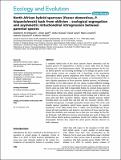Por favor, use este identificador para citar o enlazar a este item:
http://hdl.handle.net/10261/136604COMPARTIR / EXPORTAR:
 SHARE SHARE
 CORE
BASE CORE
BASE
|
|
| Visualizar otros formatos: MARC | Dublin Core | RDF | ORE | MODS | METS | DIDL | DATACITE | |

| Título: | North African hybrid sparrows (Passer domesticus, P. hispaniolensis) back from oblivion – ecological segregation and asymmetric mitochondrial introgression between parental species |
Autor: | Belkacem, Abdelkrim Ait; Gast, Oliver; Stuckas, Heiko; Canal, David CSIC ORCID ; LoValvo, Mario; Giacalone, Gabriele; Päckert, Martin | Fecha de publicación: | 2016 | Editor: | Wiley-Blackwell | Citación: | Ecology and Evolution, 2016; 6(15): 5190– 5206 | Resumen: | A stabilized hybrid form of the house sparrow (Passer domesticus) and the Spanish sparrow (P. hispaniolensis) is known as Passer italiae from the Italian Peninsula and a few Mediterranean islands. The growing attention for the Italian hybrid sparrow and increasing knowledge on its biology and genetic constitution greatly contrast the complete lack of knowledge of the long-known phenotypical hybrid sparrow populations from North Africa. Our study provides new data on the breeding biology and variation of mitochondrial DNA in three Algerian populations of house sparrows, Spanish sparrows, and phenotypical hybrids. In two field seasons, the two species occupied different breeding habitats: Spanish sparrows were only found in rural areas outside the cities and bred in open-cup nests built in large jujube bushes. In contrast, house sparrows bred only in the town centers and occupied nesting holes in walls of buildings. Phenotypical hybrids were always associated with house sparrow populations. House sparrows and phenotypical hybrids started breeding mid of March, and most pairs had three successive clutches, whereas Spanish sparrows started breeding almost one month later and had only two successive clutches. Mitochondrial introgression is strongly asymmetric because about 75% of the rural Spanish sparrow population carried house sparrow haplotypes. In contrast, populations of the Italian hybrid form, P. italiae, were genetically least diverse among all study populations and showed a near-fixation of house sparrow haplotypes that elsewhere were extremely rare or that were even unique for the Italian Peninsula. Such differences between mitochondrial gene pools of Italian and North African hybrid sparrow populations provide first evidence that different demographic histories have shaped the extant genetic diversity observed on both continents. | Versión del editor: | http://dx.doi.org/10.1002/ece3.2274 | URI: | http://hdl.handle.net/10261/136604 | DOI: | 10.1002/ece3.2274 |
| Aparece en las colecciones: | (EBD) Artículos |
Ficheros en este ítem:
| Fichero | Descripción | Tamaño | Formato | |
|---|---|---|---|---|
| Belkacem_et_al-2016-Ecology_and_Evolution.pdf | 3,29 MB | Adobe PDF |  Visualizar/Abrir |
CORE Recommender
PubMed Central
Citations
6
checked on 24-abr-2024
SCOPUSTM
Citations
19
checked on 06-may-2024
WEB OF SCIENCETM
Citations
16
checked on 24-feb-2024
Page view(s)
267
checked on 10-may-2024
Download(s)
293
checked on 10-may-2024
Google ScholarTM
Check
Altmetric
Altmetric
Artículos relacionados:
NOTA: Los ítems de Digital.CSIC están protegidos por copyright, con todos los derechos reservados, a menos que se indique lo contrario.
